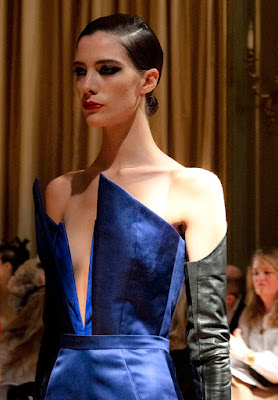 |
| Shimmering and sculptural gold gown made from recycled mixed media at Ronald Van Der Kemp's SS20 haute couture show in Paris. Cover picture and all photography by Elli Ioannou for DAM |
Dutch designer Ronald Van Der Kemp's label RVDK is at the forefront of the upcycling movement in fashion, a highlight at Paris Couture last month. Other fashion houses such as Maison Margiela and Julie de Libran also presented collections using repurposed materials. We look at how RVDK's latest Spring/Summer 2020 collection embodies the high end of sustainable fashion. Story by Jeanne-Marie Cilento and Elli Ioannou
 |
| Designer Ronald Van Der Kemp backstage in Paris |
"Since 2014 we have been on a mission to reinvent the notion of a couture house for the future," says the designer. "Creating couture from unwanted materials because we believe what's deemed useless today is able to be remade into beautiful pieces tomorrow. We keep those discarded fragments and turn them into an evolving wardrobe."
There are also ready to wear designers enthused by upcycling and the possibilities for changing the way fashion is produced. Young British designer Bethany Williams only uses recycled and organic materials and won the Queen Elizabeth II Award for British Design last year. She was one of four of eight LVMH Prize finalists using repurposed materials in their collections.
Another Dutch designer, Duran Latnik, uses pre-owned pieces from famous labels to create eclectic collections of refashioned clothes. He has also worked with Browns Boutique and Liberty London. Upcycling even has a certification process now called “UpMade” to make sure brands are meeting the right criteria. .
"We are on a mission to reinvent the notion of a couture house for the future."
 |
| A beautifully-cut gown that recalls Grace Jones in her '80s heyday |
Van Der Kemp says the aim of his brand is to fuel "a mindful movement for the sake of beauty and for the sake of our planet." He launched his RVDK label during Paris haute couture six years ago. His first collections were made up of limited-edition pieces for all seasons, created with existing fabrics by hand, in Amsterdam ateliers.
The luxury ecommerce company, Net-a-Porter, was the first retailer to buy van der Kemp’s collection. His clothes have a high profile following now and are worn by singers including Lady Gaga and Katy Perry and models Kate Moss and Karlie Kloss.
Ronald Van Der Kemp first started his career in fashion as a creative director, head designer and consultant for brands such as Guy Laroche, Celine and Bill Blass, working in New York, Paris and Milan. He originally graduated in fashion design from the Gerrit Rietveld Academy of Art and Design in Amsterdam in 1989.
For this latest Spring/Summer 2020 collection in Paris, Ronald Van Der Kemp created 38 looks using 15 pieces from previous collections including seven upcycled items and 21 new editions and styles. All of the new collection was made with existing materials that came from leftover fabrics.
The designer says his aim for the label is to fuel "a mindful movement for the sake of beauty and for the sake of our planet"
 |
| A wonderfully luxe coat made of black and gold scraps |
This collection was inspired by the glamourous nightclubs of the Eighties such as Le Palace and Club Sept where Grace Jones and Jean Paul Gaultier partied. The “Boucherite Guilt-Free Fur Trash Coat” (image at left) is made of small pieces of gold and black scraps from previous seasons. Van Der Kemp wanted to created the look of a "luxurious fur coat" while making a statement against unsustainable fake fur.
The coat was hand-made by Carpet For Life, a small organisation that works to empower Moroccan women in small villages in the Sahara. It generates an income to preserve their heritage and support their communities by using traditional Boucherite weaving techniques to make carpets from leftover clothes or fabrics.
All of the new collection was made with existing materials that came from leftover textiles
 |
| A sleek, shard-shaped bodice that shows the RVDK tailoring virtuosity |
There were also stylish, pared-back, black and white looks like a long dress with a leather harness back and wool, sateen trumpet evening skirt with over-embroidered lampshade petticoat and leather-dipped finger gloves that had a dashing Grace Jones aesthetic. The monotone looks were mixed with dashes of brilliant colour like bougainvillea pink, glossy gowns with wide shoulders and slimline black cigarette trousers worn with draped and ruffled tops.
Ronald Van Der Kamp shows his mastery and imagination using upcycled materials and how they can be used to produce coherent and captivating collections. Utilizing the skilful virtuosity of haute couture ateliers like fine tailoring combined with repurposed materials, the designer has found a way to make high fashion more sustainable.
Consumers and some luxury manufacturers are beginning to understand the colossal waste of unsold clothes and unused textiles in terms of both the production process and their eventual disposal. Ronald Van Der Kemp's vision of upcycling means that highly desirable clothes, handbags and shoes can be created from repurposed materials while landfills are alleviated.









